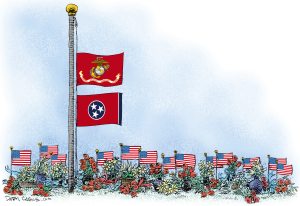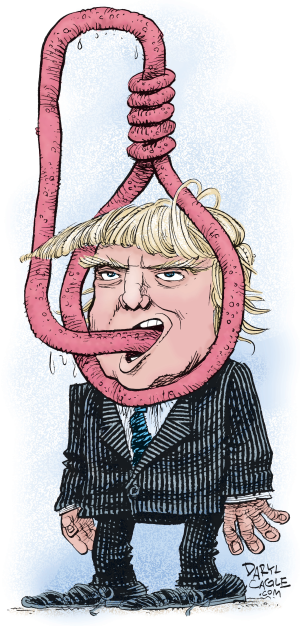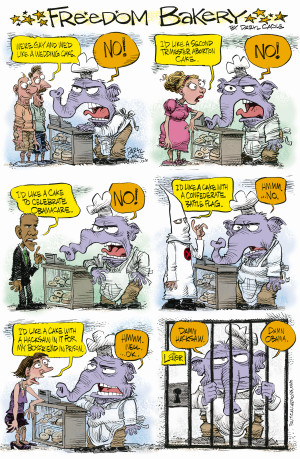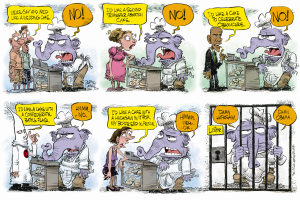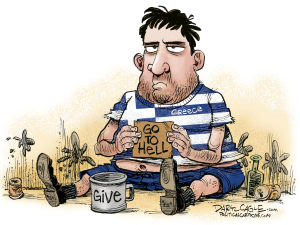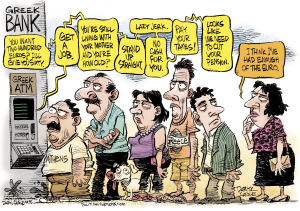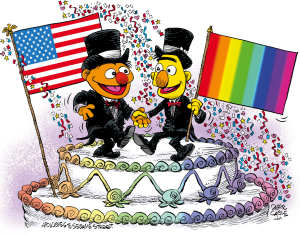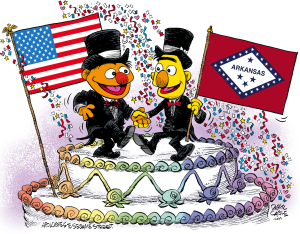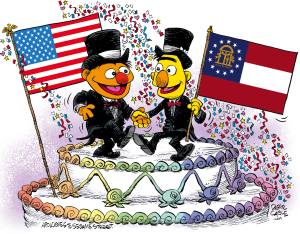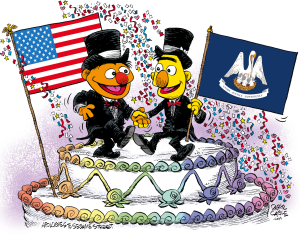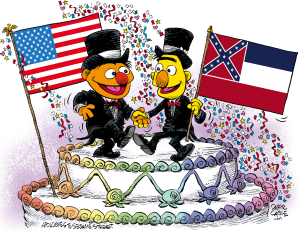
Mike Lane Retires
I’m saddened to write that one of the great editorial cartoonists has decided to retire. Mike Lane, who drew for the Baltimore Sun for decades and was one of the very first cartoonists to form our little syndicate, is calling it quits.
Mike stopped drawing early last month when he was slated for open heart surgery, but he assures me that health is not the reason for his retirement; he just feels it is time to move on. Â Mike writes,
My quitting editorial cartooning comes because it’s time, not because of my health. Which is quite good, notwithstanding. The operation was a terrific success, my recovery is rapid (as can be) and my repaired heart promises a long and robust future.
Mike writes about retirement:
When I was with The (Baltimore) Sun, I used to refer to my old cartooning pal Tommy Flannery (The Sun) and me (The Evening Sun) as the Rosencrantz and Guildenstern of The Sunpapers.
R. and G. were minor characters in Hamlet, plotting and conniving and generally being a nuisance, not part of the aristocracy but always there. That is a fair description of the role of the editorial cartoonist , don’t you think? In the end Shakespeare kills them off: “Rosencrantz and Guildenstern are dead!”
Well, Rosencrantz (Tommy) is dead but Guildenstern (me) lives on! And it’s time for different plays, acts and so, I’ve drawn my last political/editorial cartoon. Time for watercolors, greeting cards, perhaps, whatever.
Mike’s last cartoon, from August 6th before his surgery, is below. Â See an archive of Mike’s cartoons here. Your work is wonderful, Mike. Â Editorial cartoon fans already miss you!

More Arrogant Crap from the Huffington Post
The Huffington Post, which famously pays nothing to its writers, has a ridiculous piece by Jason Notte about “Ten Features That Are Dying with your Newspaper;” included on the list are editorial cartoons and one comic, The Family Circus. Notte writes:
9. Editorial Cartoons: You know those witty, insightful, stinging illustrated summaries of current events that make their way onto the op-ed page? In 10 years, you may be in the minority. If newspaper’s death knell is ringing, editorial cartoonists are pulling the rope. The head of the American Association of Editorial Cartoonists said four years ago that the number of full-time editorial cartoonists in the U.S. had dropped from 200 to 80. For his part, cartoonist and AAEC president Ted Rall has been putting together nearly as many layoff updates as illustrations these days. Remember when censorship was an editorial cartoonist’sbiggest worry? Apparently, those were the good times.
This is typical of the Huffington Post’s attitude about the “death of newspapers” as they crow about how they are the next new big thing in journalism ““ although they operate on round after round of venture financing, without a sustainable business model, stocked with content from volunteers.
Editorial cartoons have never been more popular. With the Web in addition to newspapers, political cartoonists now have the largest audience they have ever had. Political cartoons are featured on state mandated testing in high schools in every state and teachers teach to the tests, creating new fans of our art form every year. The work being done by editorial cartoonists now is better than ever before.

We syndicate a package of editorial cartoons. We’re seeing a small decline in newspaper sales that is being offset by an increase in other kinds of sales that we get though being easy to find on the Web. Our syndication business is flat, which is disappointing, but it is fine. The audience for cartoons continues to grow.
There are about 1,500 daily newspapers in the USA, of that number, probably about 80 employ full time cartoonists. Ten years ago there were more than 100, ten years before that maybe 140, back in 1960 there were probably about 200 newspapers that employed full time editorial cartoonists. That is a big percentage decline in the number of cartooning jobs in the past fifty years, but it is not a big drop in the number as a percentage of the total number of newspapers ““ the vast majority of newspapers have never employed a full time cartoonist.
I scream and wail about the loss of full time cartoonist jobs and the decline in newspapers, but the truth is it has always been unusual for a newspaper to hire a cartoonist. Newspapers have been running inexpensive syndicated cartoons for many decades and those syndicated cartoonists are the stars whose work gets seen, while local cartoonists are obscure. Syndication pays poorly because of decades of competition between the syndicates with an oversupply of good cartoons and has little or nothing to do with the decline of newspapers.
We are not seeing a decline in the number of active editorial cartoonists with the losses of full time jobs; just the opposite is happening, there are more now, plugging away as freelancers, scraping a living together from paying and non-paying clients.
The current situation for cartoonists is no different than the situation Notte finds himself in – with a big audience for his work as he writes for free for the Huffington Post, while also writing for a variety of odd clients. There will always be plenty of editorial cartoonists and plenty of writers, like Notte, plying their freelance trade no matter what happens to newspapers.

?
Every time I open a newspaper I read another story about the decline of newspapers. Political cartoonists were the canaries in the newspaper-decline-coal-mine; our ranks have been shrinking for the past 30 years — but now the pace has quickened as only a few dozen editorial cartoonists are left, and they seem to be losing their jobs at a pace of about one per week.
Political cartoons won’t disappear. As long as there is a newspaper left, with a space for a cartoonist to fill, a cartoonist will step up to draw. What we’re seeing is the “McDonaldsization” of editorial cartoons. Like McDonalds, there aren’t a lot of choices on the menu, everything on the menu is pretty good, and everyone, everywhere, chooses from the same, few menu choices. We may soon be left with just a dozen political cartoonists, perhaps the best ones, drawing for all the newspapers — just as we all watch the same news on TV, buy the same products at Wal-Mart, and eat the same food at McDonalds.
To fans of political cartoons, the list of prominent political cartoonists who have recently lost their jobs is shocking. Here is a partial list:
Gary Brookins, The Richmond Times Dispatch (Va.). Buyout.
Tom Meyer, San Francisco Chronicle (Calif.). buyout.
Bill Day, The Commercial Appeal (Memphis,Tenn.). Laid off.
John Branch, San Antonio Express-News (Texas). Laid off.
David Horsey, Seattle Post-Intelligencer (Wash.). Newspaper closed, will continue to work for Web site.
Jim Borgman, The Cincinatti Enquirer (Ohio). Buy out.
Eric Devericks, The Seattle Times (Wash.). Laid off.
Lee Judge, The Kansas City Star (Mo.). Laid off, now freelances.
Don Wright, The Palm Beach Post (Fla.). Buyout.
Steve Greenberg, Ventura County Star (Calif.). Laid off.
Stuart Carlson, Milwaukee Journal-Sentinel (Wisc.). Buyout.
Ed Stein, Rocky Mountain News (Colo.), Newspaper closed. Continues to draw in syndication.
Drew Litton (Sports Cartoonist) Rocky Mountain News (Colo.). Newspaper closed. Continues to draw in syndication.
Ben Sargent, Austin American-Statesman (Texas). Buyout.
Brian Duffy, The Des Moines Register (Iowa). Laid off.
Bill Schorr, quit print syndication.
Bill Garner, The Washington Times (D.C.). Laid off.
Kevin “Kal” Kallaugher, The Sun (Baltimore, Md.). Laid off.
Patrick O’Connor, Daily News (Los Angeles, Calif.). Laid off.
Corky Trinidad, Honolulu Star-Bulletin (Hawaii). Died; position not refilled.
Dick Adair, The Honolulu Advertiser (Hawaii). Laid Off.
Dwane Powell, The News & Observer (Raleigh, N.C.). Now freelances.
Jim Lange, The Oklahoman (Oklahoma City, Okla.). “Early” retirement.
Chip Bok, Akron Beacon-Journal (Ohio). Buyout.
Peter Dunlap-Shohl, Anchorage Daily News (Alaska). Buyout.
Sandy Huffaker, retired from syndication.
Jake Fuller, The Gainesville Sun (Fla.). Laid off.
Dave Granlund, The MetroWest Daily News (Framingham, Mass.). Laid Off.
Paul Combs, left syndication after leaving The Tampa Tribune (Fla.); position not refilled.
Mike Shelton, The Orange County Register (Calif.). Laid off.
Gordon Campbell, Inland Valley Daily Bulletin (Ontario, Calif.). Laid off.
Richard Crowson, The Wichita Eagle (Kan.). Laid off.
Mike Peters, Dayton Daily News (Ohio). Cut back on the number of editorial cartoons he draws.
Ann Telnaes, quit print syndication to focus on animation.
David Catrow, Springfield News-Sun (Ohio). Left to work on other projects.
Daryl Cagle is a political cartoonist and blogger for MSNBC.com; he is a past president of the National Cartoonists Society and his cartoons are syndicated to more than 850 newspapers, including the paper you are reading. Daryl’s books “The BIG Book of Campaign 2008 Political Cartoons” and “The Best Political Cartoons of the Year, 2009 Edition” are available in bookstores now. Read Daryl’s blog at www.blog.cagle.com/daryl.
—
Daryl Cagle, Cartoonist for msnbc.com
http://cagle.msnbc.com
http://caglepost.com
Blog: http://blog.cagle.com/daryl
Twitter: dcagle
The Death of Newspapers

Cartoonists and Cockroaches

A column in Sunday’s Los Angeles Times starts off like this:
“POPE JOHN XXIII, or ‘Good Pope John,’ remains one of the most beloved figures in recent Catholic history. Among treasured memories of this kindly, roly-poly pope, perhaps none looms larger than the evening of Oct. 11, 1962, when he told a vast crowd on a moonlit night in St. Peter’s Square, ‘Go home tonight and give your children a kiss, and tell them that this kiss comes from the pope.’ When German Cardinal Joseph Ratzinger, the Vatican’s stern doctrinal enforcer, was elected as Benedict XVI in April, an editorial cartoon in an Italian paper showed him looking at a similar crowd and saying, ‘Go home tonight and give your children a spanking, and tell them that this spanking comes from the pope.’
“In a nutshell, the cartoon captured many people’s expectations of Benedict XVI: a hard-line taskmaster who would bring liberals and dissenters in Roman Catholicism to heel.”
Speakers and columnists, like this one, often quote cartoons but seldom mention the name of the cartoonist. With this writer, one fourth of his column came from an uncredited cartoonist. (I think it is fitting that one fourth of my own column starts off with a quote from a writer whom I have chosen not to name.) Writers are almost always named when they are quoted, but cartoons seem to be mere anecdotes that deserve no attribution beyond, “I saw this cartoon …”
An unnamed op-ed page editor at the Los Angeles Times told me that he doesn’t like political cartoons because they tend to “overpower the words that surround them.” He went on to tell me that his two favorite cartoonists are Tom Toles and Ted Rall, two cartoonists with rudimentary drawing styles who put lots of words into their cartoons; this editor liked these cartoonists because they were “more like writers than artists.”
There seems to be a natural friction between the “picture people” and the “word people” who are troubled by those powerful pictures. A famously unnamed editor at The New York Times is quoted as saying, “We would never hire an editorial cartoonist at the Times, because we would never give so much power to one man.” Another unnamed New York Times editor is quoted as saying, “We don’t like editorial cartoons at the Times because you can’t edit a cartoon like you can edit words.”
Editors see cartoonists as “bomb throwers,” because cartoonists enjoy a different set of journalist ethics than writers. Cartoonists can put any words into the mouth of a public figure, whether those words were actual quotes or not. Cartoons make readers angry. A strong political cartoon generates much more mail from readers than the strongest words. Most editors are timid and want to avoid controversy; they choose to run syndicated cartoons that are unobjectionable gags about current topics. Cartoonists call this “Newsweekification” after the inoffensive, bland and opinionless – but funny – political cartoons that Newsweek magazine chooses to reprint each week, further trivializing political cartoons.
The power and effectiveness of political cartoons cause more and more newspapers to avoid cartoons. There are half as many editorial cartoonist jobs as there were 75 years ago. Of the biggest newspapers in America – The Wall Street Journal, USA Today, The New York Times, the New York Daily News, the Chicago Tribune – none have political cartoonists on staff.
The newspaper industry often complains about a dwindling and aging readership as younger readers prefer to get their news through other media. The old-line “word people” lament that youngsters nowadays get their news from Jon Stewart on “The Daily Show.” In fact, most young people get their news from political cartoons. Every state in the United States has middle and high school students interpret an editorial cartoon as part of state-mandated testing. Teachers who must “teach to the test” include political cartoons in their classes. Students learn their current events through political cartoons and, ironically, most of the students see newspaper political cartoons on the Internet rather than on paper (visit www.cagle.com). The “word people” who run newspapers have “Newspapers In Education” programs to try to develop a younger readership, but when a stack of newspapers is dropped on a teacher’s doorstep once a week, there is usually only one political cartoon on the editorial page – not very useful to a teacher who only needs the newspaper to teach about editorial cartoons.
Perhaps in the future we’ll see this turn around, and see more columns like this one, where cartoonists’ names are mentioned and writers’ names are not; when that happens, I expect traditional newspapers will have long gone extinct. Just as the cockroach will continue to roam the Earth long after mankind has disappeared, political cartoonists will still be crawling out from dark corners long after the “word people” have killed off newspapers.
Daryl Cagle is a political cartoonist and blogger for MSNBC.com. He is a past president of the National Cartoonists Society and his cartoons are syndicated to more than 800 newspapers, including the paper you are reading. His books “The BIG Book of Bush Cartoons” and “The Best Political Cartoons of the Year, 2005 Edition,” are available in bookstores now.


